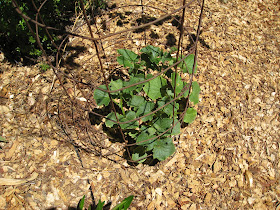After seeing how seedlings in soil blocks do not wilt, even in 100
degree F heat, I tried many ways to get this same result after
transplanting the seedlings in the ground.
But it
seemed that every time I took a soil block seedling and transplanted it
in the ground, it wilted in heat. Each time I had covered the soil
block entirely with ground dirt.
It seems the soil
block not only supplied enough water, but also air to the roots. When I
buried the soil block it cut off easy access to air. This happened even
when I transplanted a soil block plant into a 15 gallon air-pot.
Finally I tried this transplanting setup in the diagram and it has worked great so far, no wilting even in hot weather for cucumber transplants.
Basically grow your transplant in a net pot, or repot a 2-3" transplant into a 5" net pot.
Then dig a 5" hole in the garden where you want the plant. Put the net pot in, only bury the bottom half of the net pot. Put woodchips in the remaining top up to and over the surface of the net pot.
Now the roots can grow out into the soil, but also get a lot of air b/c of the unburied top half.
I believe it is important not to use peat moss as your seedling mix, because the top half may dry out and become hydrophobic, causing severe plant wilt.
I used soil/compost that I scrapped off the ground around a pine tree, very rich organic material.
I had tried using this material in a soil block, but after compressing it, it was too dense and seeds wouldn't germinate or grow well. Put into a net pot though and seeds sprouted and grew well.
Here's a cucumber seedling that was grown in a 3" peat moss soil block, then put in a 5" net pot with compost/forest mix surrounding the soil block. I transplanted it in the ground about a week ago.
Here is a close up of the pot & roots, with the wood chips temporarily moved away. Notice that the root have already started to grow out into the wood chips, providing more aeration.
This plant hasn't wilted yet after one week and one hot day.
About a month ago, after seeing the results of vertical hugelkultur, I prepared another bed with 3 vertical stumps in them. To test out this method further.
I first planted a cucumber seedling from a peat moss 3" soil block. It was planted in the ground on top of the wood wicking wafer. This one wilted and needed shade for a couple weeks to get established in the ground.
Next, the idea came for just covering half the transplant with soil. So then I took 2 cucumber seedlings in 3" peat soil blocks, put them in net pots. One with compost around it, one with just clay dirt around it. And planted them in the soil. I did not at this point cover the plantings with wood chips.
Here's a picture of them several days after transplanting. I watered them every day, except this day.
Neither had wilted before, but now the one on the right was wilting. It was the one with clay in the net pot.
While the soil in the ground was wet, the clay in the net pot had dried out and formed a hard crust. I believe the main reason for the wilting was the roots could not get enough air. Right under the crust the soil was wet.
The soil in the net pot on the left was still damp, it's plant did not wilt.
Close up of plant on left, non-wilting with forest compost in net pot.
Close up of plant on right, wilting with clay in net pot.
Next I top watered the plants and put some wood chips on top of the plant in clay.
After about 10-15 minutes it recovered.
Later, I covered both planting holes with wood chips. Initially, I though this would cut off to much air and might cause wilting, as had filling the hole with soil did in the first planting. But the wood chips proved to provide enough air exchange and the plants did not wilt, and it was easier to keep them watered enough, so they didn't wilt from dry soil. Here are the two plants today almost 3 weeks after transplanting.
Here on the left is the originally planted cuke that needed shading. It was transplanted almost 2 weeks before the other two. (The right plant is the same as the left plant in the picture above.)
I'm very excited to see how these 3 cucumber plants grow. Will the two net pot ones stay wilt free, even when they get bigger?? Hopefully the stumps underneath them will help with this. Will the net pots planted in the ground restrict the roots and stunt the plants somewhat. I don't believe so, but want to see.
Also I want to see if the one planted first becomes completely wilt free once it roots grow bigger and reach the stump below it. It now still wilts some in heat.
Up to this time all the transplants have been first 3" peat soil blocks put into net pots. After seeing the problems with peat drying out when transplanting I started a squash and one more cuke in 5" net pots planted with just forest floor compost. I'll transplant them (when they are bigger) exactly as in the diagram to insure this method works. Next year I'm currently planning on doing all my own transplants this way for the entire garden, and putting stumps under everything.
5" net pot seedlings in forest floor mix, waiting to be transplanted.



















































